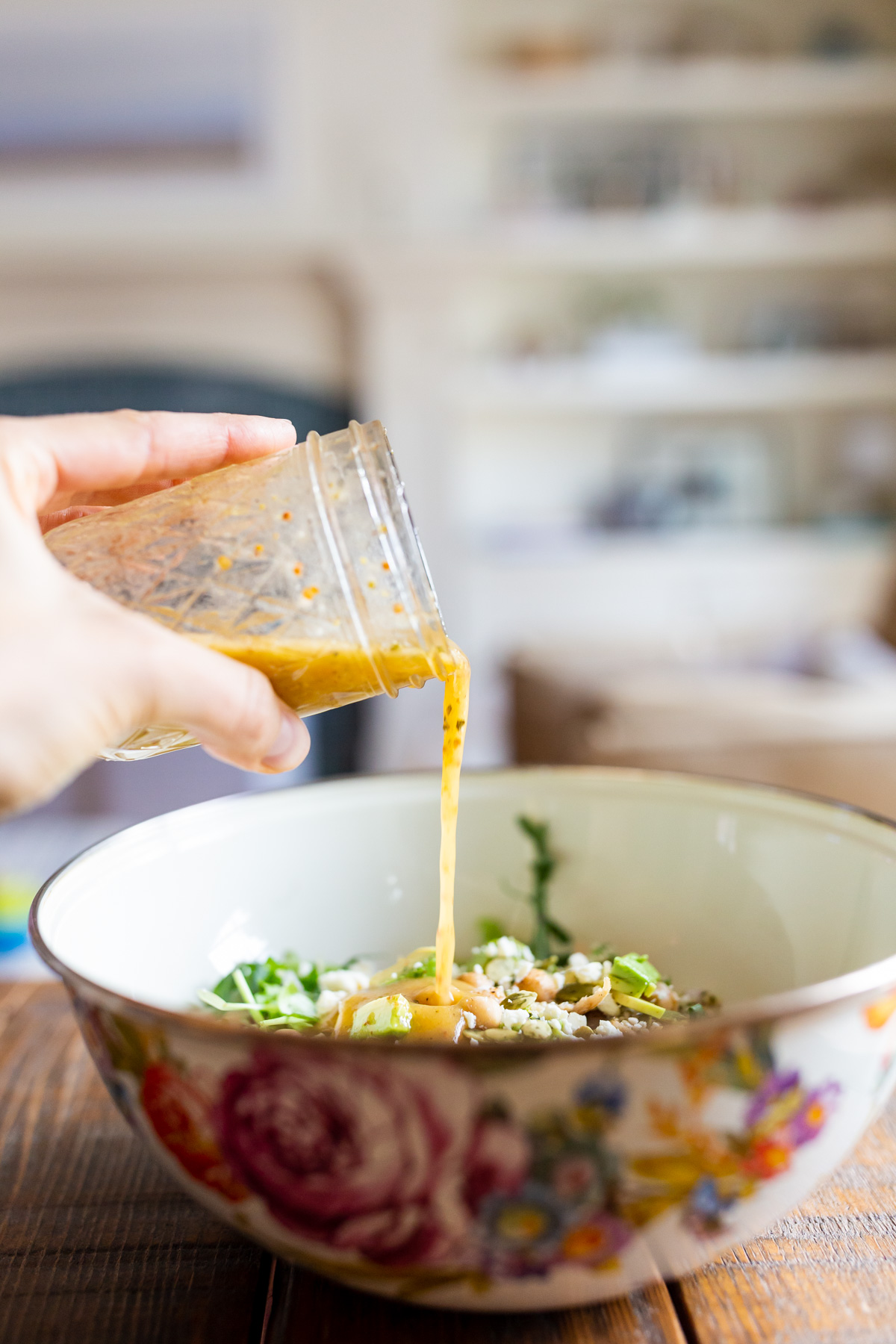
Let’s learn how to make vinaigrette, one the simplest ways to step up your salad game instantly. I’m sharing the proper ratio, plus a ton of unique combinations and recipes for you to try.
There was a time in my life that I thought salad dressing only came out of a store-bought bottle. Now, I rarely purchase vinaigrette. Why? It’s too easy to make it yourself and so much more delicious.
In this complete guide, I’m teaching you the simple art of making vinaigrette from scratch. Whether you’re a seasoned home cook or just starting out, it’s incredibly simple to create your own vinaigrette will take your culinary skills and salads to the next level.
With the right combination of ingredients, you can create endless variations of this classic dressing, each bursting with unique flavors that will have you cravings salads. From tangy balsamic vinaigrettes to zesty citrus-based dressings, we’re going to cover it all.
Learn the secrets to balancing vinegars and oils, and learn how to incorporate herbs, spices, and even fruits to create an amazing combination of flavors. No more bland salads over here.
With these step-by-step instructions and expert tips, you’ll become a vinaigrette pro in no time. Get ready to transform your little ole salad into something incredible—something you crave! Let’s dive in and master the art of flavor together!
The Basics of Vinaigrette
Proper Vinaigrette Ratio—3:1 Oil to Vinegar
The proper ratio for a vinaigrette is 3 parts oil to one part vinegar, however, rules are made to be broken! I personally like my vinaigrettes to be a little more tangy, so I often add a little more vinegar than what’s recommended. It’s up to you and your own tastebuds.
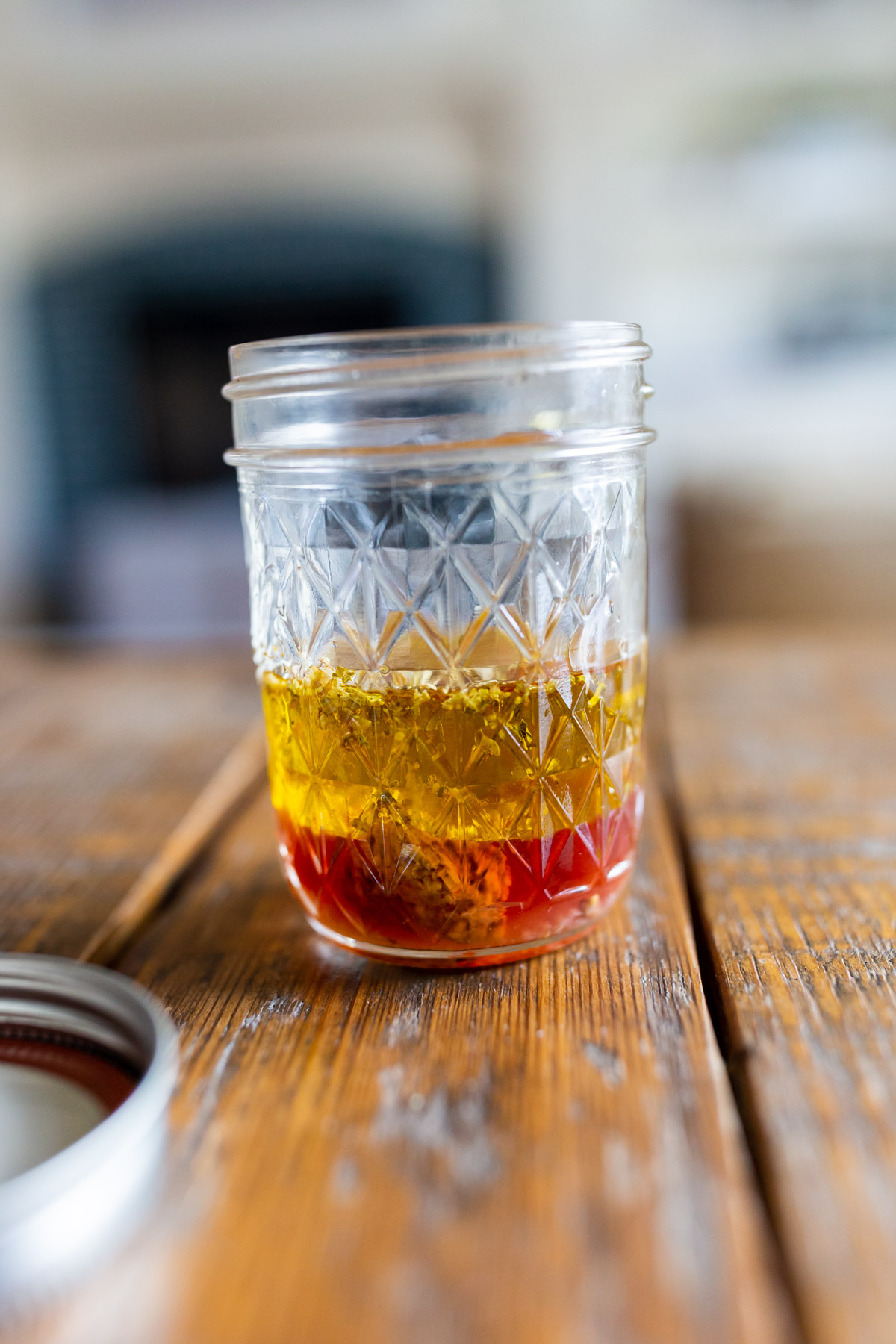
Importance of Choosing the Right Oil
Choosing the right oil is essential when making your vinaigrette because it influences both the flavor profile and overall quality of the dressing. Buying high-quality oils not only improves the flavor, but will b better for your health than cheap, refined oils.
The oil serves as the foundation, imparting richness and viscosity to the vinaigrette, and its selection can significantly impact the taste of your salad. Extra virgin olive oil is a popular choice for its robust, fruity notes that complement various salads, while neutral oils like grapeseed or avocado oil allow other ingredients, such as herbs and acids, to shine.
The balanced blend of the right oil with vinegar, herbs, and seasonings not only enhances the taste of salads but also ensures a pleasant culinary experience.
Selecting the Perfect Oil for your Vinaigrette
Extra Virgin Olive Oil:
This is my go-to oil for any salad dressing. We always have it on hand and it’s known for its rich, fruity, and robust flavor that works really well on salads. It complements a wide range of salads, from simple green salads to more complex salads. I find that the flavor is the most versatile. Plus, olive oil is great for you, so getting in a little extra each day is never a bad idea in my opinion.
Grapeseed Oil:
Grapeseed oil has a mild flavor and a high smoke point, making it a versatile option for vinaigrettes. Its neutral taste allows other ingredients, such as herbs and vinegars, to take center stage.
Avocado Oil:
With a subtle, buttery flavor, avocado oil adds a creamy texture to vinaigrettes. It pairs well with salads featuring avocados, tomatoes, or tropical fruits. Like grapeseed oil, it has a really neutral flavor that pairs well with many different types of vinaigrettes.
Toasted Sesame Oil:
Toasted sesame oil is often used in Asian-inspired vinaigrettes. It has a strong, nutty flavor and should be used in moderation to avoid overpowering the dressing. When using sesame oil, I use a neutral oil for the majority of the oil portion and finish with a teaspoon or so of toasted sesame oil because it’s that strong—in a good way! The point is, you don’t need too much of this oil to create amazing flavor.
Coconut Oil:
While solid at room temperature, coconut oil can be melted and used in vinaigrettes for a hint of tropical flavor. Because it can solidify at 75 degrees, mixing it with another oil can help prevent it from hardening. If you’re making a warm salad, you can definitely use coconut oil because it melts at 76 degrees.
Coconut oil can be a great addition to light tropical salads and Asian-flavored salads as well. I came across this unique recipe for a salad dressing with coconut oil that actually let’s it come back to it’s solid state and I have to say, I’m intrigued!
Different Types of Vinegars & Their Flavors

Vinegar is a key component in vinaigrettes, providing acidity and depth of flavor. There are various types of vinegars to choose from, each offering distinct tastes that can complement different salads. Here are some popular types of vinegars used in vinaigrettes:
Balsamic Vinegar:
Known for its rich, sweet, and complex flavor, balsamic vinegar is a favorite in vinaigrettes. It pairs well with salads featuring fruits, nuts, and aged cheeses. I love using this one in fall and winter because it has that rich taste. We love an aged balsamic in our house because they’re less acidic and thicker which results in a more creamy vinaigrette.
Red Wine Vinegar:
With a robust and slightly tangy profile, red wine vinegar adds depth to vinaigrettes. It works particularly well with Mediterranean-inspired salads and those containing bold flavors like garlic and olives. This is my go-to vinegar for Greek and Mediterranean dishes as I love the acidity and lightness.
White Wine Vinegar:
White wine vinegar has a milder taste compared to red wine vinegar. It is versatile and complements a wide range of salads, making it a popular choice for vinaigrettes with delicate greens. It’s also just a classic basic and can be a great jumping off point when adding in herbs and spices.
Apple Cider Vinegar:
Offering a slightly fruity and tangy flavor, apple cider vinegar is a versatile option for vinaigrettes. It pairs well with salads featuring autumn fruits, nuts, and vegetables. Again, another one I love to use in the fall and winter.
Sherry Vinegar:
Sherry vinegar has a complex and nuanced flavor, often with a hint of sweetness. It works well in vinaigrettes for salads with bold flavors like roasted vegetables, grilled meats, or even fruits. It’s not one I have much experience with, but I’ve had several salads at restaurants with a sherry vinaigrette and wanted to mention it.
Champagne Vinegar:
Champagne vinegar has a light and crisp taste, making it suitable for vinaigrettes in salads with delicate greens or fruits. It adds a subtle acidity without overpowering the dish. I love champagne vinegars—often you can find them blended with citrus too. They make for a light, refreshing salad dressing that everyone will love.
Rice Vinegar:
Commonly used in Asian-inspired vinaigrettes, rice vinegar has a mild and slightly sweet flavor. It pairs well with salads featuring Asian ingredients, such as sesame, soy, and ginger. I use this one frequently as my family loves a good Asian meal.
Herb or Citrus-Infused Vinegars:
There are so many amazing varieties of vinegars out there that have been infused with different herbs and even citrus. You’ll likely have to look online or in specialty grocery stores for some of these as they’re not as common, but they can be a fun way to add something really unique to your vinaigrette.
Enhancing the Flavor with Herbs, Spices & More
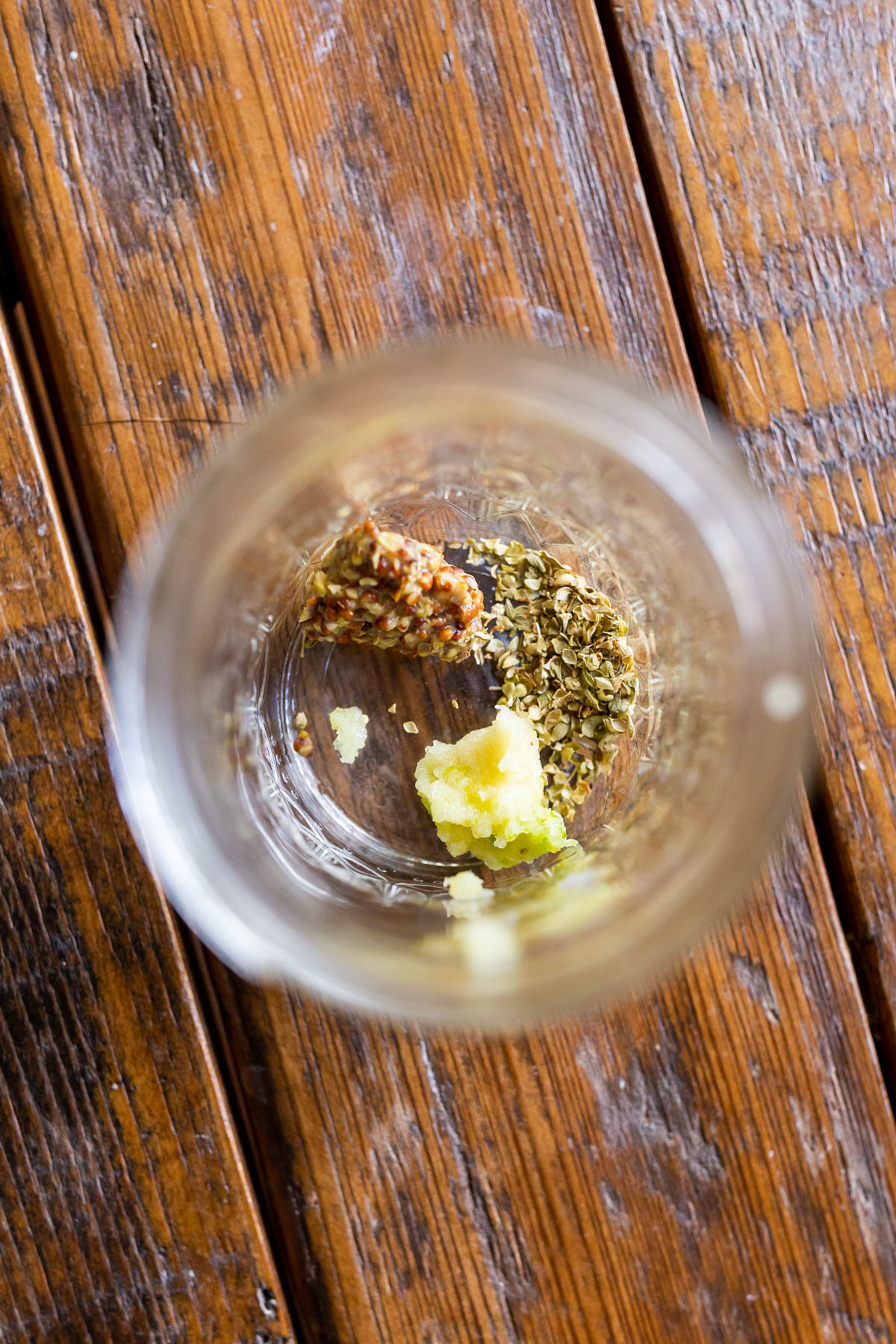
There are so many amazing flavors to add to your vinaigrette to make it really unique and fit the style of salad you’re creating. Here are just a few of my favorite herbs, spices and other additions to mix into your salad dressing. You can mix and match a few, or just use one in your dressing to create something amazing.
Basil: Amazing for any Italian or Mediterranean salads. It adds so much good flavor and a beautiful green hue (especially if you puree the dressing). Also amazing on a fresh tomato and mozzarella or burrata salad in he summer—a classic and a favorite of mine.
Oregano: Great for Greek dishes with tomatoes, cucumber and feta. You can use fresh or dried.
Shallot: Add this for a mild onion-y flavor that works well with red or white wine vinegars or even a champagne vinegar.
Dijon Mustard: I love using dijon mustard in dressings because it adds such amazing flavors and helps to emulsify (keep it from separating) the dressing.
Thyme: This would be a great addition or a salad of roasted vegetables to bring out that warmth and roasted flavor.
Garlic: Another favorite addition! I love to grate garlic and add it to dressings for a punchy bold flavor.
Dill: A nice light herb that’s great on cucumber salads and even seafood focused salads.
Mint: I love mint on Mediterranean dishes, grain salad, cucumber and tomato salads as well.
Ginger: A go-to ingredient for Asian inspired salads. It adds so much depth and unique flavor to your salad dressing.
Cilantro: A great addition to a Mexican salad with avocado, corn, beans, chicken and peppers.
Parsley: This adds a subtle herby note but isn’t overpowering. I love this for a steak salad because it reminds me of chimichurri sauce.
Chives: Yummy on a dressing for a potato salad or a fresh green salad, it adds a subtle onion flavor.
Red Pepper Flakes or Sriracha: If you want to add a spicy note to your vinaigrette, consider adding some red pepper flakes or even a squeeze of sriracha (great on Asian salads).
How to Make Vinaigrette: Step by Step Instructions & Best Methods
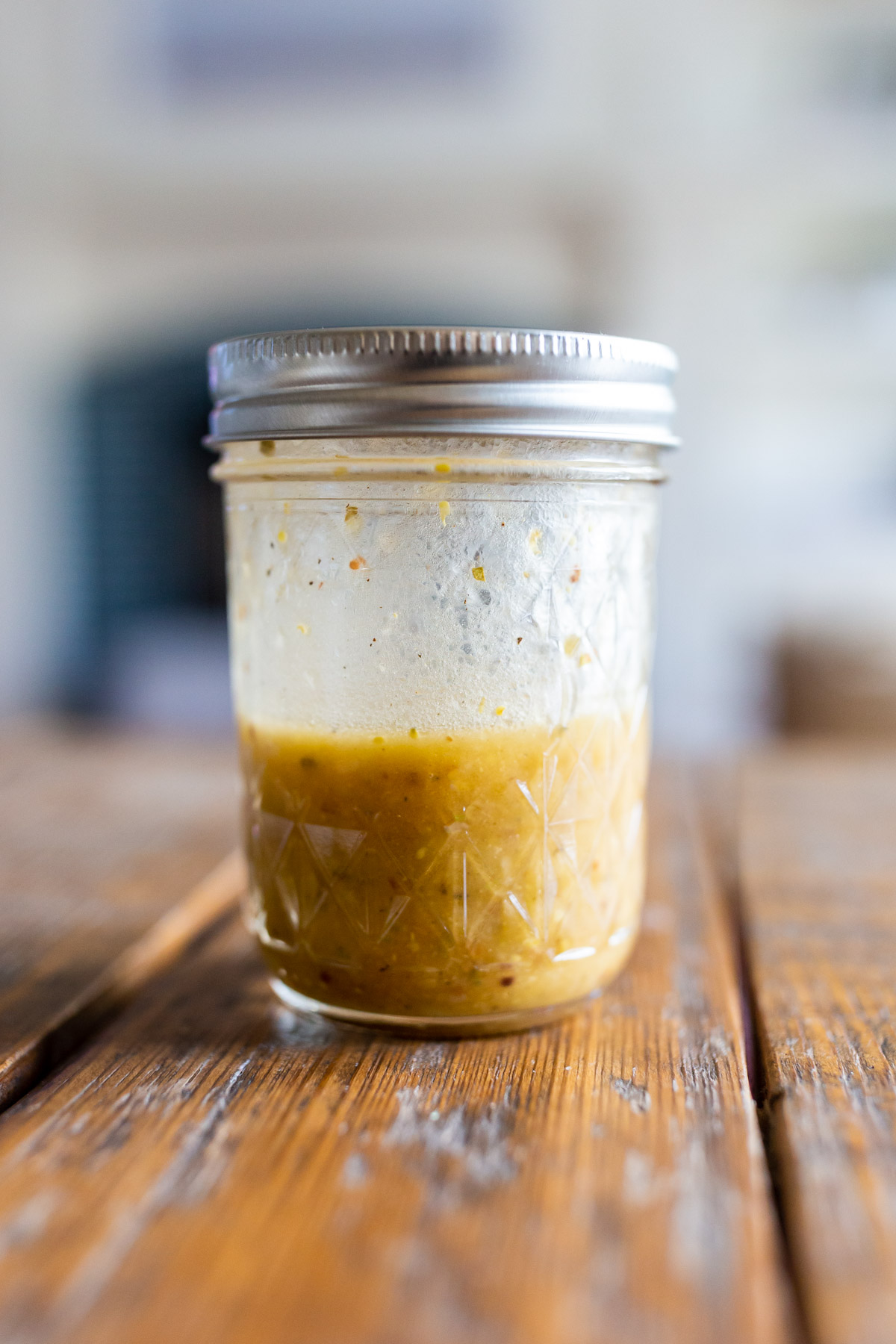
Step 1: Pick your Ingredients
You now know there are so many different oils, vinegars, herbs and spices to work with. Think about your salad’s ingredients and flavor profile to decide which ingredients make the most sense.
Step 2: Mix your Ingredients
There are a few different ways to make a vinaigrette, let’s walk through them:
Method 1: Shake in a Jar
In my opinion, this is the easiest way to mix your vinaigrette. Add all ingredients into a small glass jar, screw the top on tightly and shake vigorously to combine.
Method 2: Emulsify with Hand Blender
If you’re using fresh herbs and you don’t want big chunks of herbs or garlic in your vinaigrette, consider using a hand blender or emulsion blender. This will blend it all completely and give you a beautiful, smooth and creamy vinaigrette. You can do this with any type to create that creamy consistency.
I especially love doing this with basil or cilantro based dressings—the green color is beautiful!
Method 3: Whisk in a Bowl
Last, and the way I learned in culinary school, is to mix your vinegar and herbs and spices into a bowl and then slowly pour in the olive oil while vigorously whisking to emulsify or mix the dressing. This one takes a little more time and effort, but is a great option too.
Creative Variations & Recipes
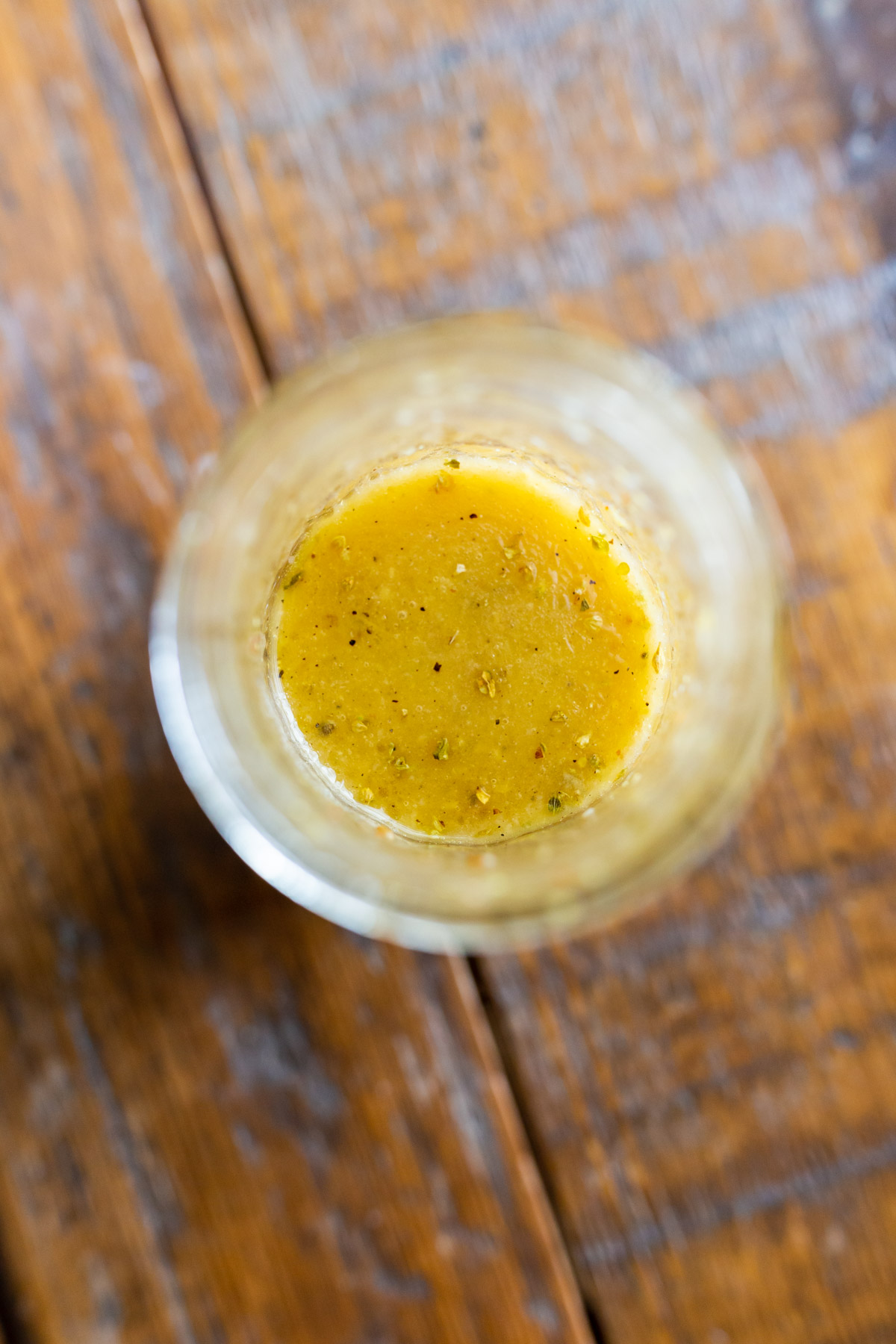
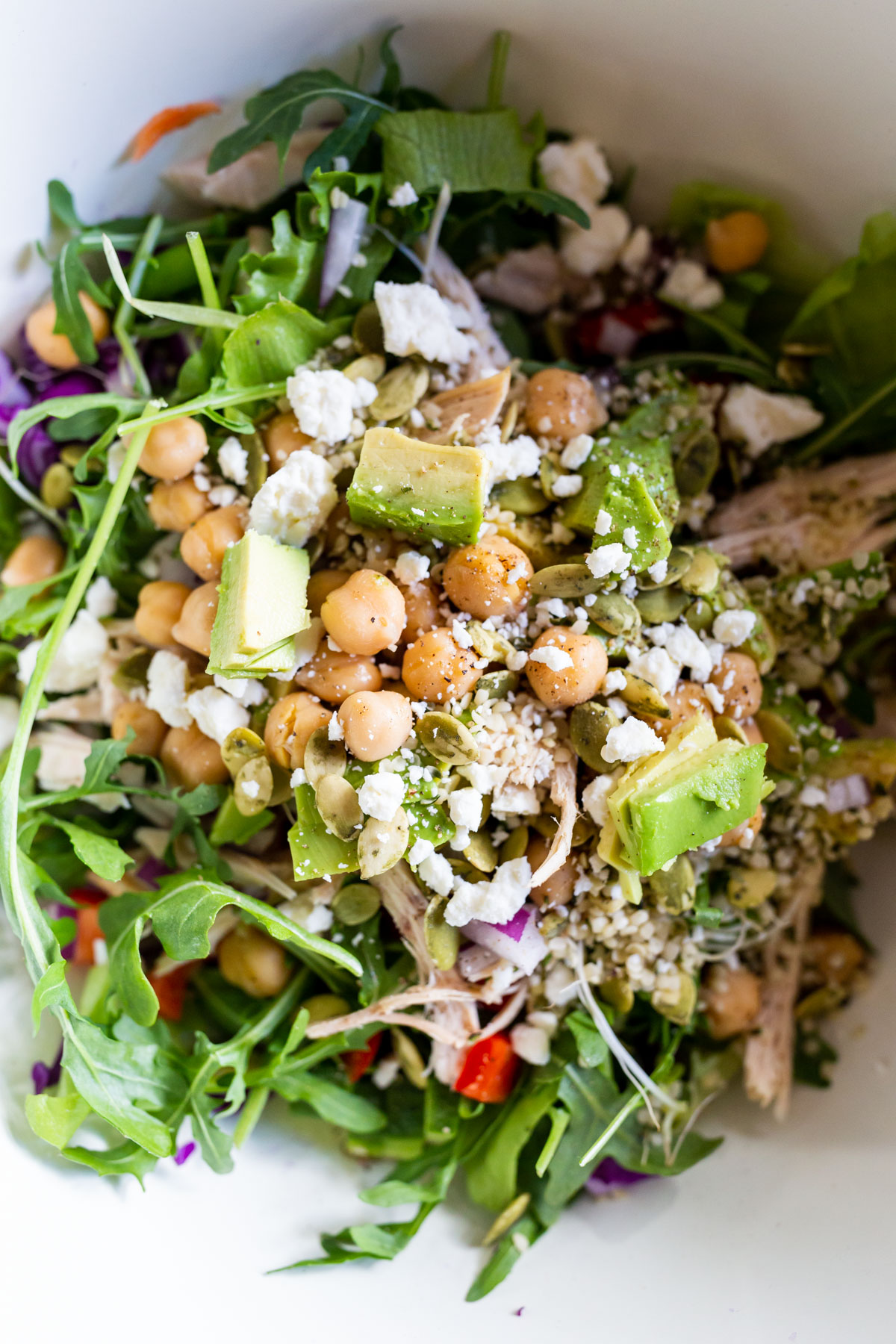
Okay, now let’s get into some delicious and simple vinaigrette recipes you need to have in your repertoire!
Simple Vinaigrette Recipe
- 1/4 cup red wine vinegar
- 2/3-3/4 cup extra virgin olive oil
- 2-3 tsp dijon mustard
- S&P
Lemon Vinaigrette Recipe
- 1/4 cup fresh lemon juice
- 2/3-3/4 cup extra virgin olive oil
- 1 clove garlic
- 1 tsp dijon mustard
- 1 tsp honey
- S&P
Champagne Vinaigrette Recipe
- 1/4 cup champagne vinegar
- 2/3-3/4 cup extra virgin olive oil
- 1 tsp dijon mustard
- 1 tsp honey
- 1 Tbsp finely chopped shallot
- S&P
Balsamic Vinaigrette Recipe
- 1/4 cup balsamic vinegar
- 2/3-3/4 cup extra virgin olive oil
- 1 clove garlic
- 1 tsp dijon mustard
- 1 tsp honey
- S&P
Mustard Vinaigrette Recipe
- 1/4 cup sherry or white wine vinegar
- 2/3-3/4 cup extra virgin olive oil
- 1 Tbsp shallot
- 1 Tbsp dijon mustard
- 1 tsp honey
- 1/2-1 tsp dried herbs, optional
- S&P
Apple Cider Vinaigrette
- 1/4 cup apple cider vinegar
- 2/3-3/4 cup extra virgin olive oil
- 1 Tbsp honey or maple syrup (a nice twist for fall dishes)
- 1 tsp dijon mustard
- S&P
Herb Vinaigrette Recipe
- 1/4 cup red wine vinegar or lemon juice
- 2/3-3/4 cup extra virgin olive oil
- 3 Tbsp chopped fresh herbs
- 1 tsp honey
- S&P
Sesame Ginger Vinaigrette
- 1/4 cup rice wine vinegar
- 2/3 cup avocado or grapeseed oil
- 2 tsp toasted sesame oil
- 2 tsp freshly grated ginger
- 1 small grated garlic clove
- S&P
Garlic Vinaigrette
- 1/4 cup white or red wine vinegar
- 2/3 cup extra virgin olive oil
- 2-3 small grated garlic clove, grated
- 1 tsp dijon mustard
- S&P
Balancing the Flavors
After you make it, taste it and tweak your salad dressing if necessary—you might need more salt, a touch of pepper, maybe it’s too tangy, so add a drizzle of honey or maple syrup to balance out the acidity.
Storing & Preserving your Vinaigrette
Most vinaigrettes will last about a week, longer if there are no fresh herbs or ingredients (garlic, ginger) more. They’ll be best the first 1-3 days so use them up! You can easily half these recipes to make a smaller amount as well, I know plenty of people won’t go through a cup of dressing in a week.
If you’re looking to make a smaller amount, use 1/4 cup of oil and 1-2 Tbsp vinegar and mix in less of the other ingredients, tasting along the way until you get it to where you like it.
More Salad Ideas to Try:
- Spiralized Zucchini Salad
- Chimichurri Steak Salad
- Grilled Peach, Tomato & Burrata Salad
- Mediterranean Chickpea Salad
- Healthy Taco Salad
- Thai Beef Salad
- Easy Tabbouleh Recipe
Making homemade vinaigrette is incredibly simple, versatile and a great way to make your salads far more interesting in flavorful. I hope you’re inspired to try some new combinations and step up your salad game in a major way!
BTW, epic Greek salad recipe, and easy and healthy salad wraps to make for lunch.





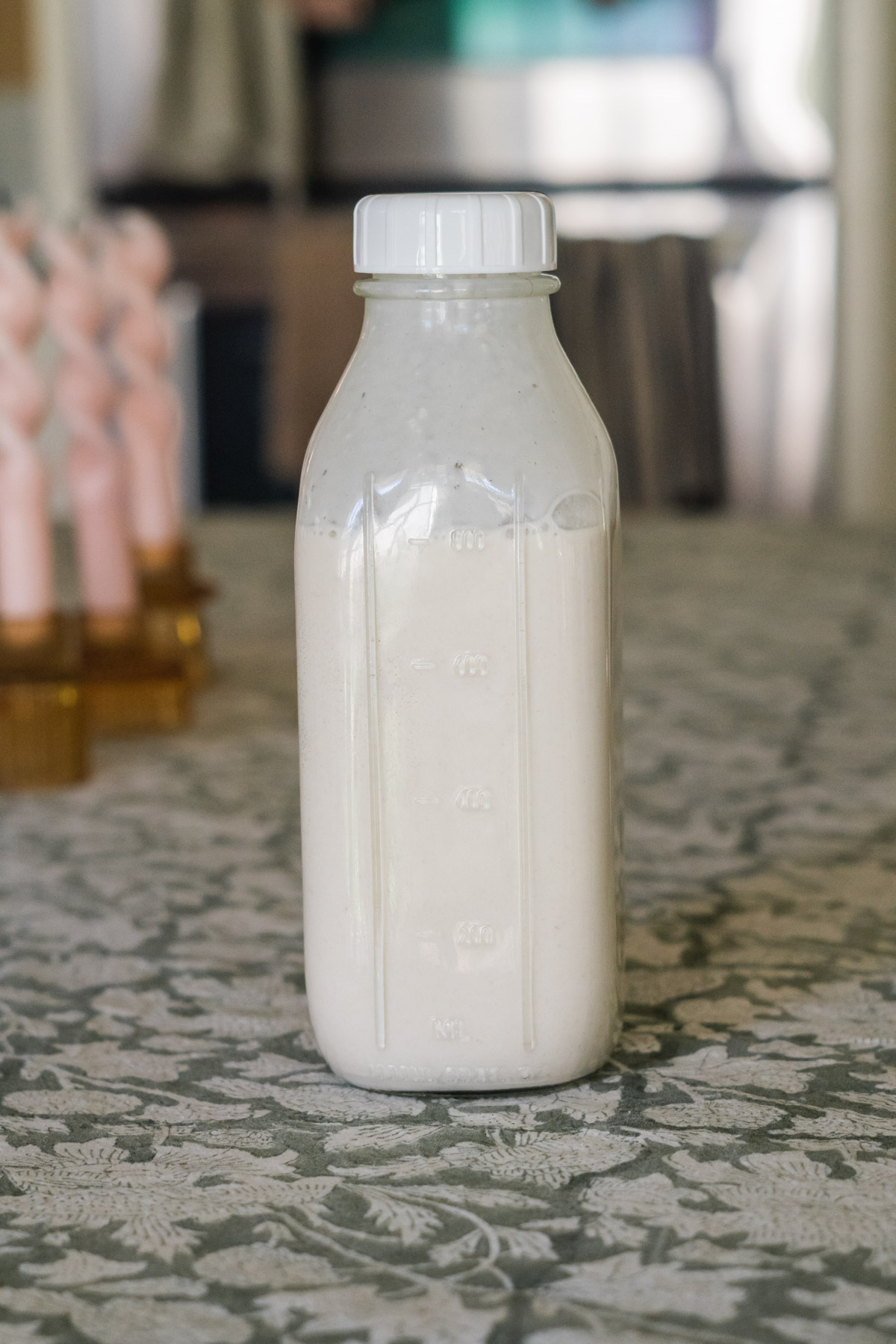


You must be logged in to post a comment.